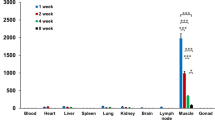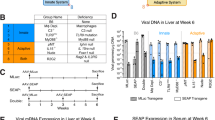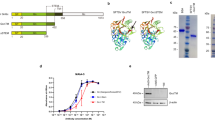Abstract
Alternative human and non-human Ad serotype vectors are currently studied for gene therapy and/or vaccine applications to capitalize upon their likely ability to avoid pre-existing immunity to HAd5. However, relatively little attention has been given to the nature and scope of innate immune responses generated by alternative Ad serotypes. In this study, we characterized several innate immune responses after intravenous administration of wild-type Ad serotypes HAd31, HAd3, HAd5, HAd37, SAd23 and HAd41, representing groups A–F, respectively. Notably, biodistribution studies revealed significant differences between the serotypes, with high levels of HAd3 genomes found in the liver and lung, and HAd37 genomes found in the spleen after systemic administration. Relative to similar treatments with other Ad serotypes, HAd3 and SAd23 induced altered innate immune responses, illustrated by induction of higher levels of cellular gene transcription in several tissues, and higher plasma levels of cytokines and chemokines. We also investigated whether complement interactions have a role in HAd3- and SAd23-induced responses. We confirmed complement dependent gene transcription, plasma cytokine/chemokine responses, and liver toxicities incurred after administration of HAd3 and SAd23. This study highlights the potential benefits and/or limitations to the proposed use of alternative Ad serotypes for gene therapy or vaccine applications.
This is a preview of subscription content, access via your institution
Access options
Subscribe to this journal
Receive 12 print issues and online access
$259.00 per year
only $21.58 per issue
Buy this article
- Purchase on Springer Link
- Instant access to full article PDF
Prices may be subject to local taxes which are calculated during checkout







Similar content being viewed by others
References
Ballay A, Levrero M, Buendia MA, Tiollais P, Perricaudet M . In vitro and in vivo synthesis of the hepatitis B virus surface antigen and of the receptor for polymerized human serum albumin from recombinant human adenoviruses. EMBO J 1985; 4: 3861–3865.
Berkner KL, Sharp PA . Expression of dihydrofolate reductase, and of the adjacent EIb region, in an Ad5-dihydrofolate reductase recombinant virus. Nucleic Acids Res 1984; 12: 1925–1941.
Van Doren K, Hanahan D, Gluzman Y . Infection of eucaryotic cells by helper-independent recombinant adenoviruses: early region 1 is not obligatory for integration of viral DNA. J Virol 1984; 50: 606–614.
Shu Y, Winfrey S, Yang ZY, Xu L, Rao SS, Srivastava I et al. Efficient protein boosting after plasmid DNA or recombinant adenovirus immunization with HIV-1 vaccine constructs. Vaccine 2007; 25: 1398–1408.
Cebere I, Dorrell L, McShane H, Simmons A, McCormack S, Schmidt C et al. Phase I clinical trial safety of DNA- and modified virus Ankara-vectored human immunodeficiency virus type 1 (HIV-1) vaccines administered alone and in a prime-boost regime to healthy HIV-1-uninfected volunteers. Vaccine 2006; 24: 417–425.
Tatsis N, Blejer A, Lasaro MO, Hensley SE, Cun A, Tesema L et al. A CD46-binding chimpanzee adenovirus vector as a vaccine carrier. Mol Ther 2007; 15: 608–617.
Bergelson JM, Cunningham JA, Droguett G, Kurt-Jones EA, Krithivas A, Hong JS et al. Isolation of a common receptor for Coxsackie B viruses and adenoviruses 2 and 5. Science 1997; 275: 1320–1323.
Roelvink PW, Lizonova A, Lee JG, Li Y, Bergelson JM, Finberg RW et al. The coxsackievirus-adenovirus receptor protein can function as a cellular attachment protein for adenovirus serotypes from subgroups A, C, D, E, and F. J Virol 1998; 72: 7909–7915.
Hartman ZC, Kiang A, Everett RS, Serra D, Yang XY, Clay TM et al. Adenovirus infection triggers a rapid, MyD88-regulated transcriptome response critical to acute-phase and adaptive immune responses in vivo. J Virol 2007; 81: 1796–1812.
Kiang A, Hartman ZC, Everett RS, Serra D, Jiang H, Frank MM et al. Multiple innate inflammatory responses induced after systemic adenovirus vector delivery depend on a functional complement system. Mol Ther 2006; 14: 588–598.
Muruve DA, Barnes MJ, Stillman IE, Libermann TA . Adenoviral gene therapy leads to rapid induction of multiple chemokines and acute neutrophil-dependent hepatic injury in vivo. Hum Gene Ther 1999; 10: 965–976.
Gall J, Kass-Eisler A, Leinwand L, Falck-Pedersen E . Adenovirus type 5 and 7 capsid chimera: fiber replacement alters receptor tropism without affecting primary immune neutralization epitopes. J Virol 1996; 70: 2116–2123.
Krasnykh VN, Mikheeva GV, Douglas JT, Curiel DT . Generation of recombinant adenovirus vectors with modified fibers for altering viral tropism. J Virol 1996; 70: 6839–6846.
Stevenson SC, Rollence M, Marshall-Neff J, McClelland A . Selective targeting of human cells by a chimeric adenovirus vector containing a modified fiber protein. J Virol 1997; 71: 4782–4790.
Arnberg N, Kidd AH, Edlund K, Nilsson J, Pring-Akerblom P, Wadell G . Adenovirus type 37 binds to cell surface sialic acid through a charge-dependent interaction. Virology 2002; 302: 33–43.
Gaggar A, Shayakhmetov DM, Lieber A . CD46 is a cellular receptor for group B adenoviruses. Nat Med 2003; 9: 1408–1412.
Tuve S, Wang H, Ware C, Liu Y, Gaggar A, Bernt K et al. A new group B adenovirus receptor is expressed at high levels on human stem and tumor cells. J Virol 2006; 80: 12109–12120.
Bangari DS, Mittal SK . Current strategies and future directions for eluding adenoviral vector immunity. Curr Gene Ther 2006; 6: 215–226.
Stone D, Lieber A . New serotypes of adenoviral vectors. Curr Opin Mol Ther 2006; 8: 423–431.
Abbink P, Lemckert AA, Ewald BA, Lynch DM, Denholtz M, Smits S et al. Comparative seroprevalence and immunogenicity of six rare serotype recombinant adenovirus vaccine vectors from subgroups B and d. J Virol 2007; 81: 4654–4663.
Roy S, Gao G, Lu Y, Zhou X, Lock M, Calcedo R et al. Characterization of a family of chimpanzee adenoviruses and development of molecular clones for gene transfer vectors. Hum Gene Ther 2004; 15: 519–530.
Zakhartchouk AN, Wu Q, Tikoo SK . Construction of capsid-modified recombinant bovine adenovirus type 3. Methods Mol Med 2007; 130: 91–106.
Wang JX, Zheng L, Song SX, Zhang X, Li LM, Wang F et al. Augmented humoral and cellular immune responses induced by canine adenovirus type 1 DNA vaccine in BALB/c mice. Viral Immunol 2007; 20: 461–468.
Hammond JM, Johnson MA . Porcine adenovirus as a delivery system for swine vaccines and immunotherapeutics. Vet J 2005; 169: 17–27.
Vogels R, Zuijdgeest D, van Rijnsoever R, Hartkoorn E, Damen I, de Bethune MP et al. Replication-deficient human adenovirus type 35 vectors for gene transfer and vaccination: efficient human cell infection and bypass of preexisting adenovirus immunity. J Virol 2003; 77: 8263–8271.
Lemiale F, Haddada H, Nabel GJ, Brough DE, King CR, Gall JG . Novel adenovirus vaccine vectors based on the enteric-tropic serotype 41. Vaccine 2007; 25: 2074–2084.
Roberts DM, Nanda A, Havenga MJ, Abbink P, Lynch DM, Ewald BA et al. Hexon-chimaeric adenovirus serotype 5 vectors circumvent pre-existing anti-vector immunity. Nature 2006; 441: 239–243.
Holterman L, Vogels R, van der Vlugt R, Sieuwerts M, Grimbergen J, Kaspers J et al. Novel replication-incompetent vector derived from adenovirus type 11 (Ad11) for vaccination and gene therapy: low seroprevalence and non-cross-reactivity with Ad5. J Virol 2004; 78: 13207–13215.
McConnell MJ, Imperiale MJ . Biology of adenovirus and its use as a vector for gene therapy. Hum Gene Ther 2004; 15: 1022–1033.
Hartman ZC, Appledorn DM, Serra D, Glass O, Mendelson T, Clay TM et al. Replication-attenuated Human Adenoviral Type 4 vectors elicit capsid dependent enhanced innate immune responses that are partially dependent upon interactions with the complement system. Virololgy (in press).
Maizel Jr JV, White DO, Scharff MD . The polypeptides of adenovirus. I. Evidence for multiple protein components in the virion and a comparison of types 2, 7A, and 12. Virology 1968; 36: 115–125.
Duncan SJ, Gordon FC, Gregory DW, McPhie JL, Postlethwaite R, White R et al. Infection of mouse liver by human adenovirus type 5. J Gen Virol 1978; 40: 45–61.
Paielli DL, Wing MS, Rogulski KR, Gilbert JD, Kolozsvary A, Kim JH et al. Evaluation of the biodistribution, persistence, toxicity, and potential of germ-line transmission of a replication-competent human adenovirus following intraprostatic administration in the mouse. Mol Ther 2000; 1: 263–274.
Everett RS, Hodges BL, Ding EY, Xu F, Serra D, Amalfitano A . Liver toxicities typically induced by first-generation adenoviral vectors can be reduced by use of E1, E2b-deleted adenoviral vectors. Hum Gene Ther 2003; 14: 1715–1726.
Hodges BL, Serra D, Hu H, Begy CA, Chamberlain JS, Amalfitano A . Multiply deleted [E1, polymerase-, and pTP-] adenovirus vector persists despite deletion of the preterminal protein. J Gene Med 2000; 2: 250–259.
Hartman ZC, Black EP, Amalfitano A . Adenoviral infection induces a multi-faceted innate cellular immune response that is mediated by the toll-like receptor pathway in A549 cells. Virology 2007; 358: 357–372.
Iacobelli-Martinez M, Nemerow GR . Preferential activation of Toll-like receptor nine by CD46-utilizing adenoviruses. J Virol 2007; 81: 1305–1312.
Zhu J, Huang X, Yang Y . Innate immune response to adenoviral vectors is mediated by both Toll-like receptor-dependent and -independent pathways. J Virol 2007; 81: 3170–3180.
Cerullo V, Seiler MP, Mane V, Brunetti-Pierri N, Clarke C, Bertin TK et al. Toll-like receptor 9 triggers an innate immune response to helper-dependent adenoviral vectors. Mol Ther 2007; 15: 378–385.
Wolins N, Lozier J, Eggerman TL, Jones E, Aguilar-Cordova E, Vostal JG . Intravenous administration of replication-incompetent adenovirus to rhesus monkeys induces thrombocytopenia by increasing in vivo platelet clearance. Br J Haematol 2003; 123: 903–905.
Stone D, Liu Y, Shayakhmetov D, Li ZY, Ni S, Lieber A . Adenovirus-platelet interaction in blood causes virus sequestration to the reticuloendothelial system of the liver. J Virol 2007; 81: 4866–4871.
Othman M, Labelle A, Mazzetti I, Elbatarny HS, Lillicrap D . Adenovirus-induced thrombocytopenia: the role of von Willebrand factor and P-selectin in mediating accelerated platelet clearance. Blood 2007; 109: 2832–2839.
Eggerman TL, Mondoro TH, Lozier JN, Vostal JG . Adenoviral vectors do not induce, inhibit, or potentiate human platelet aggregation. Hum Gene Ther 2002; 13: 125–128.
Manickan E, Smith JS, Tian J, Eggerman TL, Lozier JN, Muller J et al. Rapid Kupffer cell death after intravenous injection of adenovirus vectors. Mol Ther 2006; 13: 108–117.
Jiang H, Wang Z, Serra D, Frank MM, Amalfitano A . Recombinant adenovirus vectors activate the alternative complement pathway, leading to the binding of human complement protein C3 independent of anti-ad antibodies. Mol Ther 2004; 10: 1140–1142.
Scott JM, Kiang A, Appledorn DM, McBride AJ, Amalfitano A . Adenovirus vector induced immune responses are dependent on multifaceted interactions with proteins of the alternative and classical complement pathways in vivo. Abstr 10th Annual Meeting Amer Soc of Gene Ther, abstract 9 2007.
Olive M, Eisenlohr L, Flomenberg N, Hsu S, Flomenberg P . The adenovirus capsid protein hexon contains a highly conserved human CD4+ T-cell epitope. Hum Gene Ther 2002; 13: 1167–1178.
Sumida SM, Truitt DM, Lemckert AA, Vogels R, Custers JH, Addo MM et al. Neutralizing antibodies to adenovirus serotype 5 vaccine vectors are directed primarily against the adenovirus hexon protein. J Immunol 2005; 174: 7179–7185.
Abrahamsen K, Kong HL, Mastrangeli A, Brough D, Lizonova A, Crystal RG et al. Construction of an adenovirus type 7a E1A- vector. J Virol 1997; 71: 8946–8951.
Aste-Amezaga M, Bett AJ, Wang F, Casimiro DR, Antonello JM, Patel DK et al. Quantitative adenovirus neutralization assays based on the secreted alkaline phosphatase reporter gene: application in epidemiologic studies and in the design of adenovector vaccines. Hum Gene Ther 2004; 15: 293–304.
Rich DP, Couture LA, Cardoza LM, Guiggio VM, Armentano D, Espino PC et al. Development and analysis of recombinant adenoviruses for gene therapy of cystic fibrosis. Hum Gene Ther 1993; 4: 461–476.
Lemckert AA, Grimbergen J, Smits S, Hartkoorn E, Holterman L, Berkhout B et al. Generation of a novel replication-incompetent adenoviral vector derived from human adenovirus type 49: manufacture on PER.C6 cells, tropism and immunogenicity. J Gen Virol 2006; 87: 2891–2899.
Sirena D, Ruzsics Z, Schaffner W, Greber UF, Hemmi S . The nucleotide sequence and a first generation gene transfer vector of species B human adenovirus serotype 3. Virology 2005; 343: 283–298.
Roy S, Gao G, Clawson DS, Vandenberghe LH, Farina SF, Wilson JM . Complete nucleotide sequences and genome organization of four chimpanzee adenoviruses. Virology 2004; 324: 361–372.
Hong SS, Karayan L, Tournier J, Curiel DT, Boulanger PA . Adenovirus type 5 fiber knob binds to MHC class I alpha2 domain at the surface of human epithelial and B lymphoblastoid cells. EMBO J 1997; 16: 2294–2306.
Dechecchi MC, Tamanini A, Bonizzato A, Cabrini G . Heparan sulfate glycosaminoglycans are involved in adenovirus type 5 and 2-host cell interactions. Virology 2000; 268: 382–390.
Shayakhmetov DM, Gaggar A, Ni S, Li ZY, Lieber A . Adenovirus binding to blood factors results in liver cell infection and hepatotoxicity. J Virol 2005; 79: 7478–7491.
Martin K, Brie A, Saulnier P, Perricaudet M, Yeh P, Vigne E . Simultaneous CAR- and alpha V integrin-binding ablation fails to reduce Ad5 liver tropism. Mol Ther 2003; 8: 485–494.
Stone D, Ni S, Li ZY, Gaggar A, DiPaolo N, Feng Q et al. Development and assessment of human adenovirus type 11 as a gene transfer vector. J Virol 2005; 79: 5090–5104.
Stone D, Liu Y, Li ZY, Tuve S, Strauss R, Lieber A . Comparison of adenoviruses from species B, C, e, and f after intravenous delivery. Mol Ther 2007; 15: 2146–2153.
Gotze O, Bianco C, Cohn ZA . The induction of macrophage spreading by factor B of the properdin system. J Exp Med 1979; 149: 372–386.
Saeki T, Nagasawa S . Expression of the binding molecules for factor B and its fragment, Bb, of human complement on human monocytes after in vitro cultivation. Immunol Lett 1989; 20: 97–101.
Sethi MS, Tabel H . Fragment Bb of bovine complement factor B: stimulatory effect on the microbicidal activity of bovine monocytes. Can J Vet Res 1990; 54: 405–409.
Sundsmo JS, Gotze O . Human monocyte spreading induced by factor B of the alternative pathway of complement activation. Cell Immunol 1980; 52: 1–17.
Sundsmo JS, Wood LM . Activated factor B (Bb) of the alternative pathway of complement activation cleaves and activates plasminogen. J Immunol 1981; 127: 877–880.
Nishimura M, Naito S . Tissue-specific mRNA expression profiles of human toll-like receptors and related genes. Biol Pharm Bull 2005; 28: 886–892.
Lieber A, He CY, Meuse L, Schowalter D, Kirillova I, Winther B et al. The role of Kupffer cell activation and viral gene expression in early liver toxicity after infusion of recombinant adenovirus vectors. J Virol 1997; 71: 8798–8807.
Schiedner G, Hertel S, Johnston M, Dries V, van Rooijen N, Kochanek S . Selective depletion or blockade of Kupffer cells leads to enhanced and prolonged hepatic transgene expression using high-capacity adenoviral vectors. Mol Ther 2003; 7: 35–43.
Worgall S, Wolff G, Falck-Pedersen E, Crystal RG . Innate immune mechanisms dominate elimination of adenoviral vectors following in vivo administration. Hum Gene Ther 1997; 8: 37–44.
Schiedner G, Bloch W, Hertel S, Johnston M, Molojavyi A, Dries V et al. A hemodynamic response to intravenous adenovirus vector particles is caused by systemic Kupffer cell-mediated activation of endothelial cells. Hum Gene Ther 2003; 14: 1631–1641.
Martin-Fernandez M, Longshaw SV, Kirby I, Santis G, Tobin MJ, Clarke DT et al. Adenovirus type-5 entry and disassembly followed in living cells by FRET, fluorescence anisotropy, and FLIM. Biophys J 2004; 87: 1316–1327.
Hensley SE, Giles-Davis W, McCoy KC, Weninger W, Ertl HC . Dendritic cell maturation, but not CD8+ T cell induction, is dependent on type I IFN signaling during vaccination with adenovirus vectors. J Immunol 2005; 175: 6032–6041.
Varnavski AN, Schlienger K, Bergelson JM, Gao GP, Wilson JM . Efficient transduction of human monocyte-derived dendritic cells by chimpanzee-derived adenoviral vector. Hum Gene Ther 2003; 14: 533–544.
Varnavski AN, Calcedo R, Bove M, Gao G, Wilson JM . Evaluation of toxicity from high-dose systemic administration of recombinant adenovirus vector in vector-naive and pre-immunized mice. Gene Therapy 2005; 12: 427–436.
Vlachaki MT, Hernandez-Garcia A, Ittmann M, Chhikara M, Aguilar LK, Zhu X et al. Impact of preimmunization on adenoviral vector expression and toxicity in a subcutaneous mouse cancer model. Mol Ther 2002; 6: 342–348.
Hodges BL, Evans HK, Everett RS, Ding EY, Serra D, Amalfitano A . Adenovirus vectors with the 100 K gene deleted and their potential for multiple gene therapy applications. J Virol 2001; 75: 5913–5920.
Hofstetter JR, Zhang A, Mayeda AR, Guscar T, Nurnberger Jr JI, Lahiri DK . Genomic DNA from mice: a comparison of recovery methods and tissue sources. Biochem Mol Med 1997; 62: 197–202.
Miletic VD, Hester CG, Frank MM . Regulation of complement activity by immunoglobulin. I. Effect of immunoglobulin isotype on C4 uptake on antibody-sensitized sheep erythrocytes and solid phase immune complexes. J Immunol 1996; 156: 749–757.
Acknowledgements
We thank S Godbehere and Z Hartman for technical support, and both the Duke University and Michigan State University Laboratory Animal support facilities for their assistance in the humane care and maintenance of the animals utilized in this work. AA was supported by the National Institutes of Health grants RO1DK-069884 and P01 CA078673, as well the Osteopathic Heritage Foundation.
Author information
Authors and Affiliations
Corresponding author
Additional information
Supplementary Information accompanies the paper on Gene Therapy website (http://www.nature.com/gt)
Rights and permissions
About this article
Cite this article
Appledorn, D., Kiang, A., McBride, A. et al. Wild-type adenoviruses from groups A–F evoke unique innate immune responses, of which HAd3 and SAd23 are partially complement dependent. Gene Ther 15, 885–901 (2008). https://doi.org/10.1038/gt.2008.18
Received:
Revised:
Accepted:
Published:
Issue Date:
DOI: https://doi.org/10.1038/gt.2008.18
Keywords
This article is cited by
-
Characterization of a Species E Adenovirus Vector as a Zika virus vaccine
Scientific Reports (2020)
-
An Ad5[E1-, E2b-]-HER2/neu vector induces immune responses and inhibits HER2/neu expressing tumor progression in Ad5 immune mice
Cancer Gene Therapy (2011)
-
Induction of Shock After Intravenous Injection of Adenovirus Vectors: A Critical Role for Platelet-activating Factor
Molecular Therapy (2010)
-
CR1/2 is an important suppressor of Adenovirus-induced innate immune responses and is required for induction of neutralizing antibodies
Gene Therapy (2009)
-
Transient Pretreatment With Glucocorticoid Ablates Innate Toxicity of Systemically Delivered Adenoviral Vectors Without Reducing Efficacy
Molecular Therapy (2009)



